Band Organ
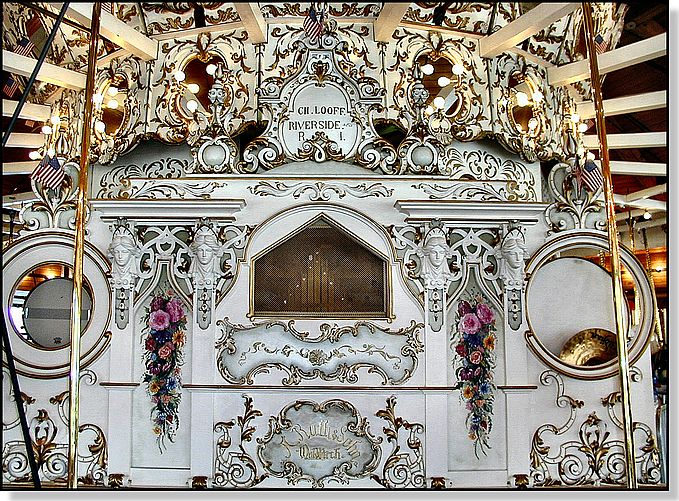 A. Ruth & Sohn Band Organ
A. Ruth & Sohn Band Organ
Model #36
Imported by Charles Looff, Circa 1900
Manufactured in Waldkirch, Germany
Our Ruth band organ was imported from Germany some time around the turn of the
last century. Looff imported the
mechanisms from Ruth, and built a facade for them to match the other decorations
on the carousel.
In the picture above, the organ blends in with the carousel so well that it's
difficult to tell which is which. The upper section with the mirrors and
light bulbs is part of the carousel, and rotates when the carousel is in motion.
The CH. LOOFF sign is at the top of the band organ. Some of the organ's pipes are
visible through the opening in the front. A snare drum can be seen on the left side of
the organ, while a bass drum and part of a cymbal are visible on the right.
Our band organ originally played songs recorded on folded cardboard sheets, or book music.
It was converted in the 1940s to play rolls similar to the rolls used in player pianos.
The organ was rebuilt in 1998 and remains in good working order today. However, it is only
played on special occasions because the rolls are deteriorating, and replacements
cannot be located. Instead, an actual recording from the band organ is played
when the carousel is in operation.
Samples
Want to hear some samples of our band organ in operation? Here are some
examples, each about a minute long:
These sound clips are provided with permission from the Spokane Antique Carrousel Society.
The Restoration
Here are some notes from Bette Largent, who was involved with the restoration and
repainting of our band organ:
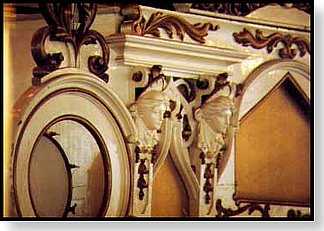
The Band Organ Ladies Before Restoration
|
When we restored the facade of the band organ, we had to go by some old photos and
a magnifying glass. We did all the gold edging as it originally was.
The facade was caving in from its own top-heavy weight and we had to shore
it up with a framework and plywood on the inside. Later facades were constructed
with three sides, which was found to be more structurally sound.
When we got it stripped, we found hand written notes in pencil on the wood,
"Oscar, coat with 3 coats of shellac". We had a lot of volunteers who worked on
the facade restoration as it was much more than we anticipated. Don Griffith
(retired Vice Principal from Mead High School) carved a lot of the small pieces that were
missing.
|
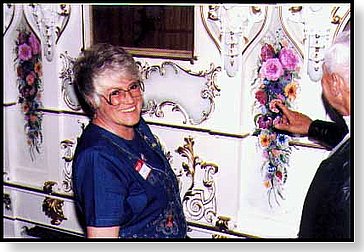
Bette Largent with Don Griffith
|
Don told me when he
started working on the horses that he didn't have an artistic bone in his
body. He now carves miniature carousel horses and makes all sorts of things,
including beautiful cradles for his grandchildren. He also developed the
student-teacher guide for us. Al Osborn, Greenacres, custom made the
missing moldings for the facade.
|
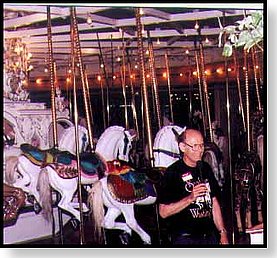
Paul Quam at the Band Organ Unveiling
|
This picture shows Paul Quam at the podium for the Band Organ unveiling for the Spokane
Antique Carrousel Society. Paul has volunteered his time for over 25 years to the carousel.
For over 20 years our carousel wore gold lame' in the blank spaces where original
paintings were, and we had speakers with matching covering. It looked nice and sounded
great when we played the tapes. We now have the speakers in the ceiling, and have restored the
paintings to their original state based on the original 1909 photos.
|
The Unveiling
On May 23, 1998, a ribbon-cutting ceremony took place at the Spokane Looff Carrousel in Riverfront Park. Cutting the ribbon on the restored Ruth Band Organ was Spokane's Mayor John Talbott and the Spokane Park Foundation President, Dennis Hession.
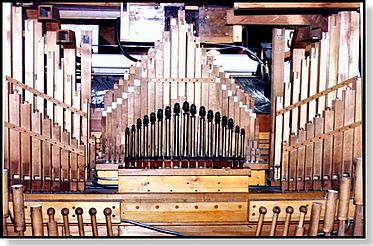
The ranks of the band organ (inside the cabinet)
|
Manufactured in Waldkirch, Germany prior to 1903, the organ with its over 300 pipes is the equivalent of a 60 piece band. A model # 36, it was the first Ruth band organ imported to the United States and originally operated with "book music", a thick, folded cardboard sheet with punched holes. It was converted to play 87-hole dual roll music by the BAB Organ Company of Brooklyn, New York in the 1940s.
Falling into disrepair again in 1984, an entire generation of children had not heard its sound until the 1998 restoration.
Tapes of the band organ (recorded by Sound Recording Company and Paul Quam in 1978) were used to play music for the carousel. The tapes were later converted to CD format, and are played
on a 5-disc CD changer that was provided by the Spokane Antique Carrousel Society.
Funding for the 1998 restoration was achieved through many channels. Grants were received from
the Spokane Park Foundation, Ferris Foundation, the Coxco Company and the Lutheran League Society.
Donations were received from private parties and small businesses.
And proceeds from a specially issued cachet honoring the issue of carousel stamps by the U. S. Postal Service were directed to the restoration of the band organ.
Once again, the greater Spokane area demonstrated their devotion to the Spokane 1909 Looff Carrousel.
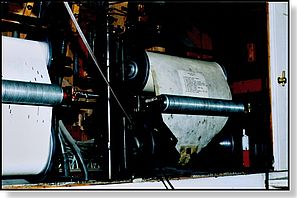
The player mechanism was converted from book music to
dual rolls in the 1940s
|
Restoration was completed by the staff of "Dan the Piano Man", who utilized local companies for specialized supplies and machining. Instrumental in the restoration were:
- George Murphy
- Brian Osso
- Dan Lloibel
Technical advice and assistance was provided, via the Web, by band organ specialists and historians through-out the United States, including:
- Brian Steptoe, England
- Hans von Oost, Secretary of the Dutch Organ Society, the Netherlands
- Wolfgang Brommer, master organ maker, Waldkirch, Germany
- Matt Caufield and Harvey Roehl, of the U. S.
- Scott Olson (the Gaviman), Missoula, Montana and Paul Quam, Spokane, Washington, who provided
the inspiration and expertise to restore our band organ
The facade restoration was done by:
- Bette Largent
- Wendy Hays
- Don Griffith
- Willy Weech
- Todd Reyfuse
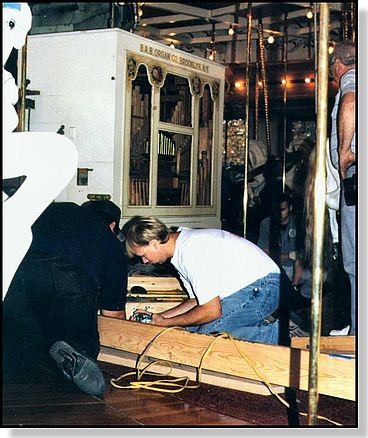
A bridge (shown here under construction) was required to get the 1200 pound band organ across the carousel's floating deck.
Visible on the band organ are the wings with
original paintings from Waldkirch, and the front that was put on by BAB in the 1940s. These will all be hidden
behind the facade.
|
A band organ was the "boom box" of the early 1900s. People would flock to the carousels at its spring opening to hear the latest top 10 tunes on this "new" musical wonder.
(The rolls are created with 10 tunes per roll.)
The predecessor to all our electronic forms of music today, it was not only enjoyed by the riders of the carousel, but by the midway travelers and avid listeners who would sit in rocking chairs that circled the carousel's perimeter. Dancers would take advantage of the outer circle of the building's hardwood floors to show off the latest dance steps or traditional polka.
Our Ruth band organ is currently played only on special occasions due to the fragile condition of its paper rolls.
It is possible to replace the worn 87-hole tracker bars, enabling the organ to be played on a
daily basis. Daily operation is important
in keeping the components of the organ (such as the pig-skin bellows) limber and operational.
A better solution would be to add a computerized MIDI-file playing system, which
would allow the organ to be played while bypassing the fragile paper rolls.
With the addition of MIDI technology, a wide variety of music ranging from Sousa marches and polkas,
to the latest love songs and other contemporary music could be played at our carousel.
The modification would not interfere with the historic roll operation. A simple switch would
allow our organ to be operated from either the paper rolls or the MIDI equipment.
Some day soon we're hoping to make the conversion to MIDI.
The latest melodies of Broadway shows, rock and roll or romantic love songs will be enjoyed by
visitors of all ages as they were when the Ruth was originally brought to the carousel floor.
May the sweet voice of the Ruth be enjoyed by our children's children!
|
Details
Here are some detail photos of the band organ. This includes the 1909 picture that was used for reference, followed by pictures taken after its 1998 restoration.
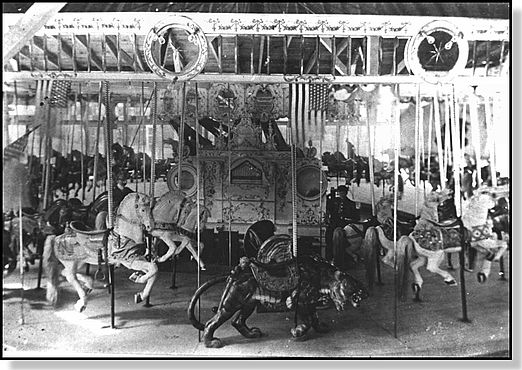
The carousel in 1909. This picture was used as reference when restoring the facade of the band organ.
Photo courtesy of the Eastern Washington Historical Society
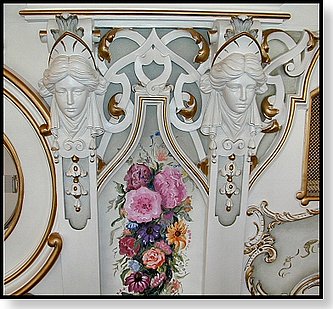
The Band Organ Ladies After Restoration
The faces are miniatures of the face on the Statue of Liberty!
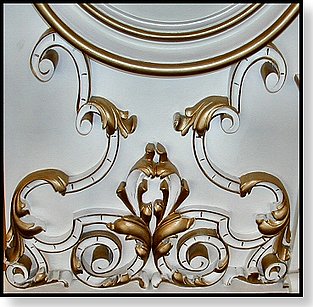
Carving Detail
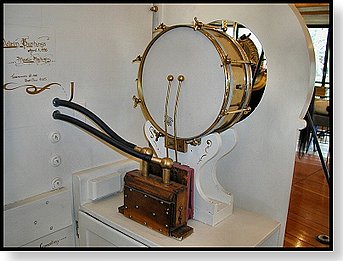
The Snare Drum and Mechanism
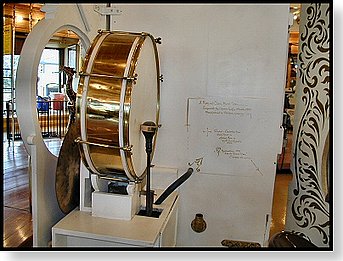
The Bass Drum, Cymbal and Mechanism
|


